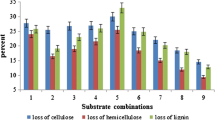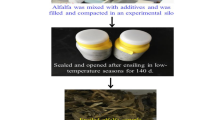Abstract
The production of four strains of edible mushroom Lentinula edodes was evaluated through solid-state fermentation (SSF) of vineyard pruning (VP), barley straw (BS), and wheat straw (WS). Biological efficiency, proximal composition, and energy value of the fruiting bodies, as well as substrate chemical changes after harvest, were determined. The shortest primordium formation time (28 days), highest biological efficiency (93.25%), highest yield (37.46%), and shortest production cycle (6 days) were observed in VP. The fruiting bodies obtained from VP had high energy value (379.09 to 392.95 kcal) and contents of protein (12.37 to 17.19%), but low contents of fat (1.82 to 2.15%). After SSF, phenol concentration decreased on VP (1.2 mmol/L) and BS (0.31 mmol/L), but on WS remained practically the same. Hemicellulose decreased in all substrates; cellulose increased on WS and decreased in the rest of the treatments. Lignin decreased on WS and BS, but its concentration increased on VP. The variability observed in the degradation capacity of lignocellulosic components was influenced by the substrate's nature, environmental factors, and genetic factors among strains. VP has great potential for shiitake production due to its low cost, short production cycles, and high biological efficiency.
Similar content being viewed by others

References
Abdullan N, Iqbal-Zafar S (1999) Lignocellulose biodegradation by white rot basidiomycetes: overview. Int J Mush Sci 2:59–78
AOAC (1990) Official methods of analysis of the Association of Official Analytical Chemist, 15th edn. AOAC International, Arlington
Belinky PA, Flikshtein N, Lechenko S, Gepstein S, Dosoretz CG (2003) Reactive species and induction of lignin peroxidase in Phanerochaete chrysosporium. Appl Environ Microbiol 69:6500–6506
Blanchette RA (1991) Delignification by wood-decay fungi. Annu Rev Phytopathol 29:381–398
Boominathan K, Reddy A (1992) Fungal degradation of lignin: biotechnological applications. In: Arora DK, Elander RP, Mkerji KG (eds) Handbook of applied mycology. Marcel Dekker, New York, pp 763–822
Box JD (1983) Investigation of the Folin–Ciocalteau phenol reagent for the determination of polyphenolic substances in natural waters. Water Res 17:511–525
Brisko NA, Babitskay VG, Bilay VT, Mitropolskaya NY (2002) Biologically active substances from Lentinula edodes and Pleurotus ostreatus. In: Sánchez JE, Huerta G, Montiel E (eds) Proceedings of the Fourth International Conference on Mushroom Biology and Mushroom Products. UAEM, México, pp 383–389
Chang ST, Miles PG (2004) Mushrooms: cultivation, nutritional value, medicinal effect, and environmental impact. CRC Press, Boca Ratón
Crisan EV, Sands A (1978). Nutritional value. In: Chang ST, Hayes WH (eds) The biology and cultivation of edible fungi. Academic, New York, pp 137–168
Delpech P, Olivier JM (1991) Cultivation of shiitake on straw based pasteurized substrates. Mushroom Sci 13:523–528
Dubois M, Gilles GA, Hamilton JK, Rebers PA, Smith F (1956) Colorimetric method for determination of sugars and related substances. Anal Chem 28:350–356
FAO (2004) Food and Agriculture Organization of the United Nations, http://www.fao.org/index_es.htm
Gaitán-Hernández R, Mata G (2004) Cultivation of edible mushroom Lentinula edodes (shiitake) in pasteurized wheat straw. Alternative use of geothermal energy in Mexico. Eng Life Sci 4:363–367
Goering HK, Van Soest PJ (1970) Forage fiber analyses. Agricultural Handbook No. 379. Agricultural Research Service. Jacket No. 387–598. USDA, Washington, DC
Hatvani N (2001) Antibacterial effect of the culture fluid of Lentinula edodes mycelium grown in submerged liquid culture. Int J Antimicrob Agents 17:71–74
Kalberer PP (2000) Influence of urea and ammonium chloride on crop yield and fruit body size of shiitake (Lentinula edodes). Mushroom Sci 15:361–366
Kilpatrick M, Murray DJ, Ward F (2000) Influence of substrate formulation and autoclave treatment on Lentinula edodes production. Mushroom Sci 15:803–810
Kirk TK, Farrell R (1987) L. Enzymatic “combustion”: the microbial degradation of lignin. Annu Rev Microbiol 41:465–505
Kozak ME, Krawczyk J (1993) Growing shiitake mushroom in a continental climate. Marinette, Wisconsin
Kües U, Liu Y (2000) Fruiting body production in basidiomycetes. Appl Microbiol Biotechnol 54:141–152
Lahman O, Rinker DL (2004) Mushroom practices and production in Latin America: 1994–2002. In: Rinker DL, Royse DJ (eds) Science and cultivation of edible and medicinal fungi. Penn State University Press, Pennsylvania, pp 681–686
Lau OW (1982) Methods of chemical analysis of mushrooms. In: Chang ST, Quimio TH (eds) Tropical mushrooms: biological nature and cultivation methods. The Chinese University Press, Hong Kong, pp 87–115
Leatham GF (1985) Extracellular enzymes produced by the cultivated mushroom Lentinula edodes during degradation of lignocellulosic medium. Appl Environ Microbiol 50:859–867
Leifa F, Pandey A, Soccol CR (1999) Growth of Lentinus edodes on coffee industry residues and fruiting body production. In: Broderick A, Nair T (eds) Proceedings of the Fourth International Conference on Mushroom Biology and Mushroom Products. University of Western Australia Press, Sydney, pp 285–292
Lin FC, Yang XM, Wang ZW (2000) Cultivation of the black oak mushroom Lentinula edodes in China. Mushroom Sci 15:955–958
Mata G, Gaitán-Hernández R (1992) Utilización de pulpa de café mezclada con viruta de madera para el crecimiento micelial de Lentinus boryanus y Lentinus edodes. Rev Mex Micol 8:125–129
Mata G, Gaitán-Hernández R (1994) Avances en el cultivo del shiitake en pulpa de café. Rev Iberoam Micol 11:90–91
Mata G, Salmones D, Guzmán G (1990) Cultivo del shiitake japonés, Lentinus edodes, en bolsas con viruta de madera. Rev Mex Micol 6:245–251
Mata G, Savoie JM, Delpech P, Olivier JM (1998) Reduction in the incidence of Trichoderma spp. Using substrate supplementation with peat and an alternative spawn during cultivation of Lentinula edodes on pasteurized wheat straw. Agronomie 18:515–520
Mendívil-Salmón C, Sánchez A, Grijalva I, Esqueda M (2001) Composición química de Pleurotus cultivado sobre residuos vitivinícolas. Rev Iber Tecnol Postcosecha 3:207–214
Morais MH, Ramos AC, Matos N, Santos-Olivera EJ (2000) Production of shiitake mushroom (Lentinula edodes) on lignocellulosic residues. Food Sci Technol Int 6:123–128
Morales P, Martínez-Carrera D (1991) Bursera sawdust as a substrate for shiitake cultivation. Micol Neotrop Apl 4:41–47
Morales P, Martínez-Carrera D, Martínez-Sánchez W (1991) Cultivo de shiitake sobre diversos substratos en México. Micol Neotrop Apl 4:75–81
Odumi S, Tominaga K, Kundou S, Hori H, Koide T, Hara S, Isemura M, Tsunasuawa S (1999) The inhibitory properties and primary structure of novel serine proteinase from the fruiting body of basidiomycete, Lentinus edodes. Eur J Biochem 262:915–923
Philippoussis A, Diamantopoulou P, Zervakis G (2002) Monitoring of mycelial growth and fructification of Lentinula edodes on several agricultural residues. In: Sánchez JE, Huerta G, Montiel (eds) Proceedings of the Fourth International Conference on Mushroom Biology and Mushroom Products. UAEM, México, pp 279–287
Pire DG, Wright JE, Albertó E (2001) Cultivation on shiitake using sawdust from widely available local woods in Argentine. Micol Aplicada Int 13:87–91
Przybylowicz P, Donoghue J (1990) Shiitake growers handbook. The art and science of mushroom cultivation. Kendall/Hunt, Dubuque
Rossi IH, Monteiro AC, Machado JO, Barbosa JC (2003) Supplementation of sugarcane bagasse with rice bran and sugarcane molasses from shiitake (Lentinula edodes) spawn production. Braz J Microbiol 34:32–37
Royse DJ (1985) Effect of spawn run time and substrate nutrition on yield and size of shiitake mushroom. Mycologia 77:756–762
Royse DJ (1996) Yield stimulation of shiitake by millet supplementation of wood chip substrate. In: Royse DJ (ed) Mushroom biology and mushroom products. Penn State University Press, Pennsylvania, pp 277–283
Salmones D, Mata G, Ramos LM, Waliszewski KN (1999) Cultivation of shiitake mushroom, Lentinula edodes, in several lignocellulosic materials originating from the subtropics. Agronomie 19:13–19
Sánchez JE, Royse DJ (2002) La biología y el cultivo de Pleurotus spp. Limusa-Grupo Noriega Editores, México
Sánchez A, Ysunza F, Beltrán-García MJ, Esqueda M (2002) Biodegradation of viticulture wastes by Pleurotus: a source of microbial and human food and its potencial use in animal feeding. J Agric Food Chem 50:2537–2542
SAS Institute (1998) SAS/STAT user's guide, release 8.02 Version. SAS Institute Inc, Cary
Savoie JM, Delpech P, Billete C, Mata G (2000) Inoculum adaptation changes the outcome of competition between Lentinula edodes and Trichoderma spp. during shiitake cultivation on pasteurized wheat straw. Mushroom Sci 15:667–674
Sobata C, Nall H (1994) Shiitake mushroom production on logs. Alabama Cooperative Extension Program, Alabama
Song CH, Chow KY (1987) A synthetic medium from the production of submerged cultures of Lentinus edodes. Mycologia 79:866–876
Van CH, Drage TC, Snape C (2003) E. Biodegradation of oak (Quercus alba) wood during growth of shiitake mushroom (Lentinula edodes): a molecular approach. J Agric Food Chem 51:947–956
Acknowledgements
The authors thank the Institute of Ecology and Research Center for Food and Development for financial support. Thanks are also due to biologists Carlos Ortega Sánchez and Norberto Cortés Esquivel of the Institute of Ecology, who generously offered their assistance in this research, and to doctors Jean Michel Savoie of France and Ruth de León of Guatemala for donating the strains employed.
Author information
Authors and Affiliations
Corresponding author
Additional information
Research was conducted at Instituto de Ecología, AC, and Centro de Investigación en Alimentación y Desarrollo, AC
Rights and permissions
About this article
Cite this article
Gaitán-Hernández, R., Esqueda, M., Gutiérrez, A. et al. Bioconversion of agrowastes by Lentinula edodes: the high potential of viticulture residues. Appl Microbiol Biotechnol 71, 432–439 (2006). https://doi.org/10.1007/s00253-005-0241-1
Received:
Revised:
Accepted:
Published:
Issue Date:
DOI: https://doi.org/10.1007/s00253-005-0241-1



